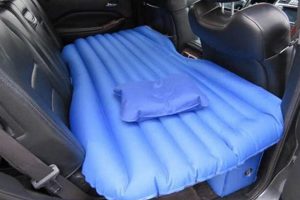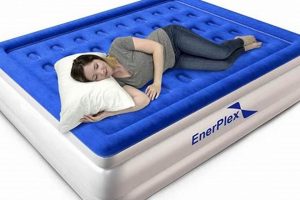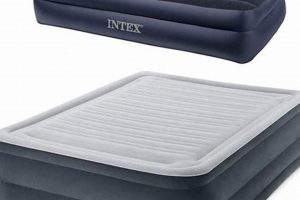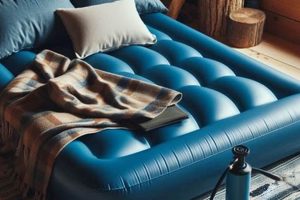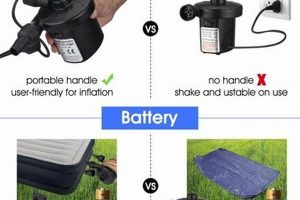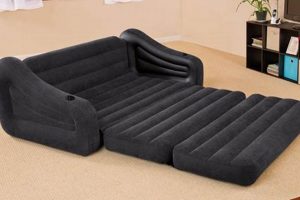A portable bed frame, often made of metal or wood and covered with canvas or other durable fabric, presents a sleeping surface elevated from the ground. Inflatable sleeping pads, typically constructed of PVC or rubber, offer a cushioned resting area when filled with air. These items serve as temporary bedding solutions in various situations.
The utility of these sleeping arrangements stems from their ease of transport, storage, and setup. They provide a readily available resting place in locations where permanent beds are unavailable or impractical. Historically, these types of sleeping solutions have been employed in military settings, camping environments, and as temporary accommodations for guests.
The selection between these temporary bedding solutions often depends on factors such as desired comfort level, portability requirements, intended use environment, and budgetary constraints. The following sections will delve into a more detailed comparison of specific characteristics and considerations relevant to choosing the appropriate option.
Selection and Use Considerations
Choosing between elevated fabric beds and inflatable sleeping surfaces requires careful assessment of individual needs and environmental factors. The following guidelines provide key considerations for optimal selection and usage.
Tip 1: Assess Intended Use. The primary application significantly influences the appropriate choice. Camping may favor durable, easily portable inflatable surfaces, while guest accommodations may benefit from the more substantial feel of an elevated fabric bed.
Tip 2: Evaluate Comfort Requirements. Individual preferences for firmness and support should guide the decision. Inflatable surfaces often allow adjustable firmness through inflation control. Elevated fabric beds provide a more consistent, albeit potentially firmer, surface.
Tip 3: Consider Portability Constraints. Evaluate the ease of transport and storage. Inflatable surfaces are generally more compact when deflated. Elevated fabric beds, while sturdier, typically require more storage space.
Tip 4: Account for Environmental Conditions. The ambient temperature and ground conditions can influence comfort. Insulating inflatable surfaces are advisable for colder climates. Elevated beds may be preferable on uneven or damp terrain.
Tip 5: Examine Durability Expectations. The expected lifespan and frequency of use should be factored in. High-quality materials and construction contribute to longevity. Reinforcement patches for inflatable surfaces may extend their use.
Tip 6: Review Space Limitations. The available space dictates the maximum dimensions. Measure the designated area to ensure adequate clearance for either choice.
Tip 7: Check Weight Capacity. Verify that the selected option can safely accommodate the intended user’s weight. Exceeding the weight limit can lead to damage or failure.
Informed selection ensures optimal comfort and usability. Careful consideration of these guidelines promotes a well-suited temporary sleeping arrangement.
This information will serve as the foundation for a comprehensive analysis of each option’s specific features and limitations.
1. Portability
Portability is a critical factor when selecting temporary sleeping arrangements. The ease with which a sleeping solution can be transported and stored directly impacts its suitability for diverse environments and uses. The inherent design differences between elevated fabric beds and inflatable sleeping surfaces significantly influence their respective portability.
- Packed Size and Weight
Inflatable sleeping surfaces typically offer superior portability due to their ability to be deflated and compressed into a significantly smaller volume. The reduced weight further enhances their transportability. In contrast, elevated fabric beds, even those designed for portability, retain their frame structure, resulting in a larger packed size and increased weight.
- Ease of Handling
The form factor of the packed item affects handling. Inflatable sleeping surfaces can often be rolled or folded into compact bundles that are easily carried or stowed. Elevated fabric beds, however, may require specialized carrying cases due to their shape and size, potentially making them more cumbersome to handle.
- Transportation Method
The intended method of transportation impacts the importance of portability. For backpacking or situations where space is severely limited, the compact size and lightweight nature of an inflatable option may be essential. If transportation is less constrained, such as car camping, the larger size and weight of an elevated fabric bed may be less of a concern.
- Storage Requirements
Portability extends beyond transport to include storage considerations. When not in use, inflatable sleeping surfaces require minimal storage space due to their deflated state. Elevated fabric beds, on the other hand, require more dedicated storage space, potentially posing a challenge in smaller living areas.
The portability characteristics of both elevated fabric beds and inflatable sleeping surfaces directly influence their applicability in various scenarios. Selection should align with specific transportation constraints and storage limitations to ensure a practical and convenient temporary sleeping solution.
2. Comfort
Comfort is a paramount consideration when evaluating temporary sleeping solutions, directly influencing rest quality and overall well-being. The design and materials of both elevated fabric beds and inflatable sleeping surfaces contribute significantly to the perceived comfort level. The firmness, support, and surface texture of each type impact the sleeping experience, affecting spinal alignment and pressure point distribution. A primary determinant of comfort is the ability of the sleeping surface to conform to the body’s contours, minimizing discomfort and promoting restful sleep. Individuals with pre-existing back conditions, for example, may find firmer, more supportive surfaces preferable, whereas others may prioritize a softer, more cushioned feel.
Inflatable sleeping surfaces allow for adjustable firmness through controlled inflation, enabling users to tailor the support level to their specific preferences. However, excessive inflation may lead to a rigid, less comfortable surface, while insufficient inflation may result in sagging and inadequate support. Elevated fabric beds, conversely, offer a more consistent level of firmness determined by the tautness of the fabric stretched across the frame. Some models incorporate padding or cushioning to enhance comfort. Real-world examples include the use of thicker inflatable pads for camping in cold weather to provide both insulation and increased cushioning. Alternatively, cots
are frequently used in emergency shelters where a stable, elevated surface is more important than customizable comfort.
Understanding the interplay between design features and individual comfort preferences is essential for selecting the appropriate temporary sleeping arrangement. Choosing a solution that aligns with personal comfort requirements maximizes the likelihood of a restorative sleep experience. The challenge lies in objectively assessing comfort levels, as subjective perceptions vary widely. Ultimately, prioritizing ergonomic design and material quality is crucial for ensuring a comfortable and supportive temporary sleep environment.
3. Durability
Durability, as it relates to temporary sleeping solutions, is paramount in determining the lifespan and reliability of the chosen product. For elevated fabric beds, durability primarily stems from the frame material (steel, aluminum, or wood) and the quality of the fabric used for the sleeping surface (canvas, nylon, or polyester). Stronger frame materials resist bending or breaking under repeated use and varying weight loads. More robust fabrics resist tearing, stretching, and abrasion, ensuring the sleeping surface remains intact over time. Real-world examples include military-grade cots constructed with heavy-gauge steel frames and reinforced canvas designed to withstand rigorous field conditions and frequent relocation. Inferior materials lead to premature failure, rendering the temporary sleeping arrangement unusable.
Inflatable sleeping surfaces derive their durability from the type and thickness of the material used in their construction, typically PVC or reinforced thermoplastic polyurethane (TPU). Thicker materials are more resistant to punctures, leaks, and seam failures. Additionally, the method of seam construction (welded or glued) significantly impacts the air retention and overall lifespan. Camping-grade air mattresses designed for outdoor use often feature multi-layered construction with puncture-resistant coatings and reinforced seams to withstand exposure to rough terrain and varying temperatures. A compromised air mattress quickly loses its utility, negating its intended purpose.
The practical significance of understanding durability lies in minimizing the need for frequent replacements and ensuring consistent performance in critical situations. Whether for emergency preparedness, camping, or accommodating guests, a durable temporary sleeping solution provides a reliable and long-lasting alternative to permanent bedding. Choosing higher-quality materials and construction methods translates to a greater return on investment and reduced risk of unexpected failures, especially in situations where a comfortable and dependable sleeping surface is essential.
4. Space required
The spatial footprint associated with temporary sleeping solutions dictates their suitability for various environments. Available space considerations are critical in selecting between elevated fabric beds and inflatable sleeping surfaces, as each presents distinct advantages and limitations relative to spatial requirements.
- Footprint in Use
Elevated fabric beds occupy a fixed rectangular area when deployed, determined by the frame dimensions. Inflatable sleeping surfaces, while conforming to the user’s body, similarly require a comparable surface area during use. Measurement of the intended space is crucial to ensure adequate clearance and prevent obstruction.
- Storage Volume
When not in use, elevated fabric beds often necessitate significant storage volume due to their rigid frame structure. Folding models mitigate this, but they still require more space than deflated inflatable surfaces. Inflatable surfaces, when deflated and packed, occupy a minimal volume, facilitating storage in confined areas.
- Maneuverability in Confined Spaces
Setting up elevated fabric beds in tight quarters can be challenging, requiring sufficient room for unfolding and positioning the frame. Inflatable surfaces offer greater maneuverability in such environments, as they can be inflated in situ, adapting to the available space. Examples include utilizing an inflatable surface in a small tent where maneuvering a cot would be impossible.
- Impact on Room Functionality
The space occupied by temporary sleeping solutions influences the residual functionality of the room. A cot, even when folded, may impede movement or limit access to other furnishings. A deflated and stored inflatable sleeping surface minimizes disruption to the room’s primary purpose.
In conclusion, the “Space required” facet significantly impacts the practicality of both elevated fabric beds and inflatable sleeping surfaces. Careful assessment of available space, both during use and in storage, ensures the selected option aligns with spatial constraints and optimizes room functionality. These findings are critical when deciding between a cot and an air mattress. For example, in tiny apartment, air mattress is best solution.
5. Ease of setup
The deployment speed and simplicity associated with temporary sleeping arrangements directly influence their practical utility, particularly in emergency situations or when accommodating unexpected guests. The setup process for elevated fabric beds generally involves unfolding the frame and securing the sleeping surface, a process that may require physical exertion and take several minutes. This can be problematic when time is of the essence or when the user has limited physical capabilities. For example, setting up multiple cots in a shelter after a natural disaster needs to be quickly and efficiently implemented. The complexity and time required for assembly can significantly affect overall response times.
Inflatable sleeping surfaces, conversely, offer a range of inflation methods that can dramatically reduce setup time. Self-inflating models require only the opening of a valve, allowing the mattress to inflate passively. Electric pumps, whether integrated or external, can inflate a mattress within minutes, significantly minimizing physical effort. A real-world example is a family camping trip where the rapid inflation of multiple air mattresses allows for a quicker transition from arrival to relaxation. The ease and speed of setup directly contribute to the convenience and usability of inflatable sleeping solutions, particularly in situations where time is a critical factor.
In summary, the “Ease of setup” characteristic significantly distinguishes elevated fabric beds and inflatable sleeping surfaces. The comparative simplicity and speed of inflating an air mattress offer a tangible advantage over the often more labor-intensive assembly of a cot. This distinction underscores the importance of considering setup requirements when selecting a temporary sleeping arrangement, particularly in scenarios where rapid deployment and minimal physical exertion are paramount. The overall value proposition of a temporary sleeping solution is directly linked to the balance between comfort, durability, and the ease with which it can be made ready for use.
6. Cost effectiveness
The economic viability of temporary sleeping solutions, namely elevated fabric beds and inflatable sleeping surfaces, warrants careful consideration. Initial purchase price, longevity, and maintenance costs collectively determine the overall cost-effectiveness of each option. A comprehensive evaluation necessitates a comparison of these factors to ascertain the long-term financial implications.
- Initial Investment
Inflatable sleeping surfaces generally exhibit a lower initial purchase price compared to elevated fabric beds. Entry-level air mattresses can be acquired at a significantly reduced cost compared to basic cots. However, high-quality, durable air mattresses featuring advanced materials and construction may approach or even exceed the price of mid-range cots. The initial investment represents only a fraction of the overall cost consideration.
- Lifespan and Replacement Costs
Elevated fabric beds, owing to their sturdier construction, typically offer a longer lifespan compared to inflatable sleeping surfaces. The robust frame and durable fabric contribute to increased resistance against wear and tear. Air mattresses are susceptible to punctures, leaks, and seam failures, necessitating more frequent replacements. Replacement costs over time can negate the initial price advantage of inflatable options.
- Maintenance and Repair Expenses
Elevated fabric beds require minimal maintenance, primarily consisting of occasional cleaning. Inflatable sleeping surfaces, however, may demand more frequent attention to address leaks or valve malfunctions. Repair kits offer temporary solutions, but extensive damage may necessitate professional repairs or complete replacement. The cumulative maintenance and repair expenses impact the long-term cost-effectiveness.
- Ancillary Costs
Additional expenses associated with temporary sleeping solutions include storage provisions and accessories. Both options may require dedicated storage space, albeit with varying volume requirements. Air pumps, repair kits, and fitted sheets represent additional costs associated with inflatable sleeping surfaces. Elevated fabric beds may necessitate the purchase of a separate mattress pad for enhanced comfort, increasing the overall investment.
Evaluating cost-effectiveness extends beyond the initial purchase price. A comprehensive assessment of lifespan, maintenance requirements, and ancillary expenses provides a more accurate depiction of the long-term financial implications. The selection between an elevated fabric bed and an inflatable sleeping surface should align with budgetary constraints, anticipated usage frequency, and desired lifespan to optimize economic value. Understanding these factors allows for selecting the most suitable option when choosing between a cot or air mattress.
7. Weight capacity
Weight capacity constitutes a critical specification for both elevated fabric beds and inflatable sleeping surfaces, directly influencing safety and product longevity. Exceeding the designated weight limit can induce structural failure in either type of sleeping arrangement, potentially resulting in injury to the user. Therefore, determining the maximum load-bearing capability is essential prior to use.
The weight capacity of a cot is primarily determined by the frame material and design. Steel frames typically support higher weight loads compared to aluminum or wooden frames. Fabric tensile strength also contributes; a durable canvas or reinforced synthetic fabric enhances the cot’s overall weight-bearing capability. For example, military-grade cots are designed to withstand significant weight, often exceeding 300 pounds, due to their robust construction. In contrast, consumer-grade cots may have lower weight limits, necessitating careful user adherence to prevent frame damage. Similarly, inflatable sleeping surfaces derive their weight capacity from the material thickness and internal construction. Thicker PVC or reinforced TPU materials, coupled with sophisticated internal baffling systems, enable higher weight ratings. Single-layer air mattresses typically exhibit lower weight capacities than multi-layered models. Exceeding the stipulated weight limit on an air mattress can lead to seam failure or puncture, rendering it unusable. An example is the rapid deflation of an air mattress used by multiple individuals exceeding its rated weight capacity.
Understanding weight capacity is paramount for ensuring both safety and product lifespan. Users should meticulously review the manufacturer’s specifications and select a sleeping solution that comfortably accommodates their weight. The ramifications of disregarding weight limits extend beyond mere discomfort; potential structural failure can lead to injuries and necessitate premature product replacement. Consequently, adherence to weight capacity guidelines is not merely a suggestion but a fundamental requirement for safe and effective utilization of temporary sleeping arrangements.
Frequently Asked Questions
The following section addresses common inquiries regarding elevated fabric beds (cots) and inflatable sleeping surfaces (air mattresses), providing factual and objective information to aid in informed decision-making.
Question 1: What constitutes the primary advantage of an elevated fabric bed over an inflatable sleeping surface?
Elevated fabric beds offer an elevated sleeping surface, facilitating easier ingress and egress. This feature can be particularly beneficial for individuals with mobility limitations.
Question 2: Conversely, what is the primary advantage of an inflatable sleeping surface relative to an elevated fabric bed?
Inflatable sleeping surfaces, when deflated, offer superior portability and require significantly less storage space compared to the bulkier structure of elevated fabric beds.
Question 3: How does one mitigate the risk of puncture with an inflatable sleeping surface?
Employing a protective barrier, such as a groundsheet or blanket, between the inflatable surface and the ground can substantially reduce the likelihood of puncture.
Question 4: What maintenance practices extend the lifespan of an elevated fabric bed?
Regular cleaning of the fabric surface and periodic inspection of the frame for signs of stress or damage contribute to the longevity of elevated fabric beds.
Question 5: Does ambient temperature influence the comfort of an inflatable sleeping surface?
Ambient temperature can affect the air pressure within an inflatable sleeping surface; cooler temperatures may cause a decrease in pressure, potentially requiring adjustments.
Question 6: Are elevated fabric beds suitable for all body types and weights?
No, elevated fabric beds possess specific weight capacity limitations; exceeding these limits can result in structural failure and potential injury. Users must consult the manufacturer’s specifications.
This FAQ section provides concise answers to common concerns. Understanding these points is critical for optimal utilization and safety.
The subsequent section will explore specific use cases for each type of sleeping solution.
Conclusion
This exposition has meticulously examined the characteristics of both elevated fabric beds and inflat
able sleeping surfaces, presenting a comprehensive analysis of their respective strengths, weaknesses, and suitability for various applications. Durability, portability, comfort, space requirements, ease of setup, cost-effectiveness, and weight capacity have been scrutinized to provide a balanced perspective. The selection between a cot or air mattress requires careful consideration of these factors in relation to specific needs and environmental constraints.
Informed decision-making is paramount. Prospective users should prioritize a thorough assessment of their individual requirements and contextual limitations before committing to a particular sleeping solution. The optimal choice will depend on a strategic alignment of practical needs with the inherent attributes of each option, ultimately ensuring a safe, comfortable, and economically sound temporary sleeping arrangement.


